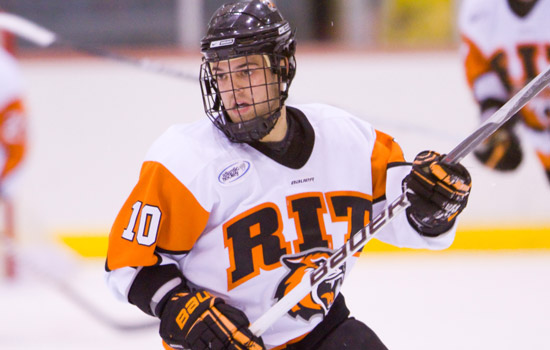Hitting the ice—and the books—to the Frozen Four
Mike Bradley
Mark Cornacchia, RIT forward
As the RIT Tigers prepare for their debut in hockey’s elite Frozen Four, their “power play” off the ice and in the classroom remains equally strong. The team’s overall GPA is a 3.3.
Defenseman Chris Haltigin and forward Mark Cornacchia are just two members of the squad who are academic achievers. The NCAA honored Cornacchia on the eve of the Tigers game against Wisconsin with the NCAA Elite 88 Award. The award is given to a player participating in the Frozen Four who has the highest cumulative grade point average. Cornacchia has a 3.85 GPA.
“It speaks to the caliber of the athletes that come here,” says Haltigin, a second-year biomedical sciences major from Oakville, Ontario, who carries a 3.72 GPA. “The guys on the hockey team are a pretty smart bunch. A lot of people don’t know how hard we have to work to maintain our marks and do as well as we do on the ice. It takes a lot of work and a lot of energy.”
Both Haltigin and Cornacchia say managing time well is key.
“Time management is really, really critical. Chris is one of my roommates and he’s a motivating factor,” says Cornacchia, a second-year finance major from Unionville, Ontario. “Chris is always down to business right away when we get home. We make a quick dinner and then it’s off to studying. There’s a lot of strain on our time, especially during the season. It’s something you have to keep an eye on. You have to balance your time.”
Time management is something they learned early on in school. To play in the NCAA, student-athletes must graduate from high school on time. They also must complete 16 core courses in English, math, natural or physical sciences, social sciences, foreign language and religion or philosophy.
Lex Sleeman, associate director for Intercollegiate Athletics and Recreation, is the NCAA compliance officer for RIT. He says Division I athletes are held to a higher standard to be certified to play. It’s part of Sleeman’s job to track each individual athlete’s progress.
“Each fall, I submit an academic progress report to the NCAA,” says Sleeman. “We are rated on various criteria including the number of credit hours each athlete takes a quarter, how many they complete and if they are on track to graduate on time. The NCAA rates each university based on a 1,000 point rating system, and RIT in the 2008-2009 academic year scored 985 points. That’s pretty impressive.”
Balancing classes, homework and game play the past couple of weeks has been a challenge for the players, especially with the road trips, but their professors have been supportive.
“The professors are really helpful and accommodating,” says Cornacchia. “It helps us a lot because we are trying to pair athletics and academics. It’s a delicate balance and we are student-athletes, student first. There are ample distractions if you want to be distracted, but if you concentrate on school, there is no reason why you can’t achieve high marks and play at a high-level.”
Adds Mary-Beth Cooper, RIT vice president for student affairs: “We are all proud that our athletes are as successful in the classroom as they are on the ice. They are in some of the most challenging courses and programs at RIT. They’ve been able to manage the quarter system, classes, sometimes co-ops and sports because they’ve seen the value of working together as a team, managing their time well.”
Part of being on a team is the ability to take some good-natured teasing from your teammates. One of Haltigin’s nicknames is “Brainiac.”
“De-Mike (Tiger goalie Jared DeMichiel) gets on me a little bit about being a rocket scientist,” says Haltigin. “I guess I’m the one on the team who studies the hardest, even though there’s a lot of us that are pretty smart, but I got the label as the guy that’s a bit of a bookworm and the glasses don’t help (laughter).”














